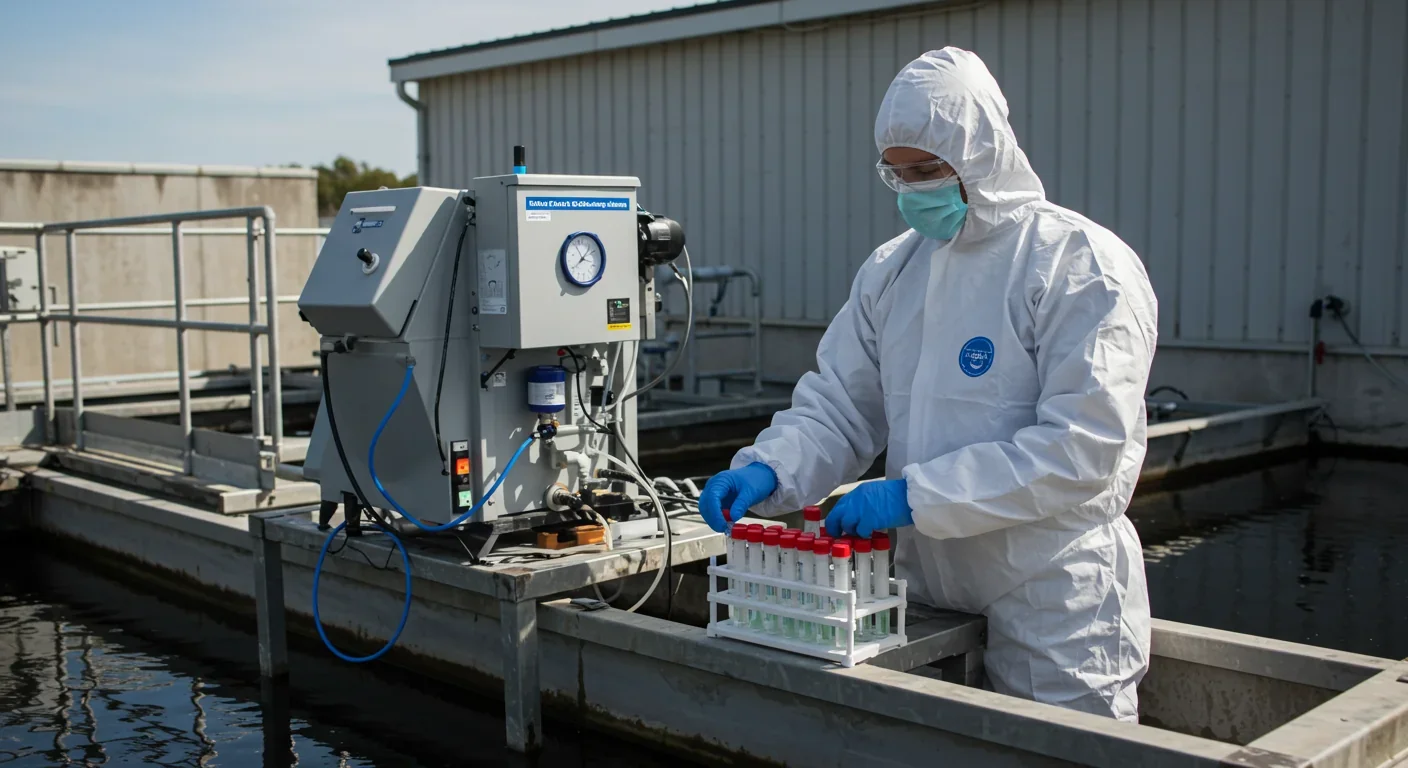How Compassion Meditation Rewires Your Brain & Cuts Inflammation

TL;DR: AI-powered genomic surveillance now tracks pathogen mutations in real time, predicting outbreaks before they spread—turning pandemic response from reactive chaos into proactive preparation.

By 2030, epidemiologists predict that genomic weather forecasts will be as routine as checking tomorrow's rain. Instead of atmospheric pressure and humidity, scientists will track mutations accumulating in pathogen genomes, spotting the next pandemic before it crosses borders. What sounds like science fiction is already happening in laboratories worldwide, where AI algorithms scan millions of genetic sequences daily, looking for the evolutionary signatures that spell trouble.
The analogy to meteorology isn't just cute wordplay. Both systems monitor continuous streams of data from distributed sensors, both look for patterns that signal incoming danger, and both aim to give us enough warning to prepare. The difference? Instead of tracking cold fronts, we're tracking genetic drift. Instead of predicting where a hurricane will make landfall, we're forecasting which country a new variant will hit first.
Genomic surveillance works by continuously collecting samples from infected individuals, sequencing their viral genomes, and uploading that data to shared databases. Think of each genome as a weather station report, except instead of temperature and pressure, it contains a string of genetic letters that spell out the virus's current evolutionary state.
The CDC alone sequences thousands of SARS-CoV-2 samples every week, providing estimates of variant proportions every Tuesday. These estimates come in two flavors: empiric (based on observed data) and nowcast (model-based projections for the most recent period). The nowcast updates constantly as new sequences arrive, much like how weather forecasts adjust with fresh radar data.
But raw sequence data means nothing without interpretation. That's where viral phylodynamics comes in, the field that connects genomic data with epidemiological, immunological, and evolutionary processes. By building phylogenetic trees (essentially family trees for viruses), scientists can trace how pathogens spread through populations, estimate when variants emerged, and identify which lineages are gaining ground.
The real breakthrough came when researchers started feeding these phylogenies into machine learning models. Traditional statistical methods could predict variant spread only after a new variant had already arrived and established significant prevalence. But graph neural networks changed the game by treating countries as nodes and modeling transmission routes as edges weighted by mobility data and border restrictions.
One team built a dynamics-informed GNN that predicts when a variant will arrive in a country before it shows up in local sequencing. Their model ingests variant prevalence from 87 countries, real-time mobility patterns, and policy changes, then forecasts arrival delays with greater accuracy than physics-informed neural networks or logistic regression. The entire benchmarking pipeline, covering 36 SARS-CoV-2 variants from August 2020 to October 2023, is publicly available for other researchers to test their models.
The key innovation was encoding time-varying border restrictions as dynamic edge weights in the graph. A static network would miss the fact that a country's import risk changes when it tightens travel rules. By updating those weights every two weeks based on real policy data, the GNN captures how human decisions reshape transmission pathways.
Tools like Nextstrain have democratized this work. Nextstrain provides web-based visualization of pathogen evolution, letting anyone with a browser explore how variants spread geographically and temporally. When scientists built a localized Nextstrain resource for Orthohantavirus, they created a unique web address where public health officials could track mutation dynamics and make policy decisions based on current genetic data, not last month's case counts.
The idea of using genetic sequences to track disease isn't new. During the 2009 H1N1 influenza pandemic, researchers analyzed just 11 viral sequences in April and calculated that the virus's common ancestor existed before January 12. That rapid genetic detective work helped pinpoint when and where the outbreak likely began.
Before that, phylodynamic analysis revealed how hepatitis B's genetic diversity in the Netherlands declined in the late 1990s after vaccination programs started. The phylogenetic signal preceded the epidemiological signal, showing that genomic data could detect public health victories before they showed up in hospital records.
Influenza has long been the proving ground for evolutionary forecasting. The A/H3N2 strain shows a distinctive "trunk and branch" phylogeny, with one main lineage persisting over decades while side branches emerge and die out within one to five years. CDC scientists use these patterns every February and September to select which strains go into the next season's vaccine, essentially making a genomic weather forecast six months out.
But those early efforts relied on painstaking manual analysis and small datasets. The COVID-19 pandemic forced a quantum leap in scale. Within months of SARS-CoV-2's emergence, researchers had sequenced hundreds of thousands of genomes and built automated pipelines to track every mutation. That infrastructure didn't disappear when the pandemic waned. It created a permanent global genomic surveillance network that now monitors influenza, Ebola, and other pathogens with the same intensity.
The West Africa Ebola epidemic from 2013 to 2016 showed what happens when you sequence pathogen genomes during an outbreak. Transcriptional analysis comparing early and late isolates found no evidence that the virus had attenuated over time despite accumulating mutations. That ruled out hopeful speculation that Ebola was evolving toward lower virulence, forcing public health responses to remain aggressive.
In Sri Lanka, genomic surveillance of influenza A from 2015 to 2020 revealed that multiple subtypes cocirculated with frequent introductions from other regions. The evolutionary dynamics showed that Sri Lanka wasn't just experiencing local flu transmission but was a node in a global network of viral flow. Similar work in Kenya and Uganda tracking influenza B from 2010 to 2021 mapped how different lineages dominated in different years, giving forecasters data to predict which strains would arrive next.
We're witnessing a fundamental transformation in how public health operates. For centuries, disease surveillance meant counting cases after people got sick. Genomic weather forecasting flips that model by detecting threats at the molecular level before clinical symptoms appear in enough people to trigger traditional alarms.
The Nepal SARS-CoV-2 genomic epidemiology project exemplifies this shift. In a country with limited laboratory infrastructure, real-time genomic tracking allowed health authorities to identify which variants were circulating and prioritize interventions accordingly. They weren't just reacting to hospitalization spikes but anticipating them based on which genetic lineages were gaining ground.
Cloud platforms like Solu have made this accessible to resource-limited settings. Solu provides an end-to-end pipeline for pathogen genomic surveillance, from raw sequence upload to phylogenetic analysis and visualization, all running in the cloud so countries don't need to build expensive local computing infrastructure.
The transformation extends to vaccine development. Instead of waiting to see which flu strains cause the most illness, scientists can now analyze which hemagglutinin mutations are accumulating in circulating viruses and predict which will evade existing immunity. This shifts vaccine formulation from retrospective to prospective, reducing the mismatch between vaccine strains and circulating strains.
Wastewater surveillance adds another dimension. The Covvfit model analyzes SARS-CoV-2 sequences from sewage samples to track selection dynamics and forecast which variants will become dominant. Because wastewater captures viral genomes from entire communities, including asymptomatic and undiagnosed cases, it provides an unbiased sample that clinical testing can't match.
This creates a multi-layered early warning system. Clinical surveillance tells you who's sick now. Wastewater surveillance tells you what's circulating in the community. Genomic surveillance tells you what's coming next. Together, they form a forecasting toolkit that rivals meteorology in sophistication.

The most obvious benefit is time. During COVID-19, genomic surveillance identified the Omicron variant in late November 2021, weeks before it became dominant in most countries. That early warning let governments prepare, hospitals stock up, and researchers start testing whether existing vaccines would work. A few weeks might not sound like much, but in pandemic time, it's the difference between controlled preparation and chaotic scramble.
Early variant detection also guides therapeutic development. When genomic data shows a new lineage acquiring mutations in the spike protein's receptor-binding domain, drug developers know that monoclonal antibodies targeting those regions might lose efficacy. They can start testing and reformulating treatments before clinical failures pile up.
For vaccine manufacturers, genomic forecasting enables just-in-time production. Instead of making hundreds of millions of doses based on last year's dominant strain, companies can monitor which variants are expanding in multiple countries and shift production toward those antigens. This reduces waste from vaccines that target obsolete strains and ensures that doses match circulating threats.
Public health messaging improves too. When officials can point to genomic data showing that a more transmissible variant is arriving, compliance with preventive measures tends to increase. People grasp that the threat is evolving, not static. Clear visualizations of variant spread on platforms like Nextstrain make the invisible visible, turning abstract mutation counts into comprehensible geographic and temporal patterns.
Genomic weather forecasts also help allocate resources. If models predict a new variant will hit Region A before Region B, you can pre-position tests, treatments, and personnel accordingly. During the COVID pandemic, some countries used variant forecasts to decide when to tighten border controls or reimpose social distancing, tailoring responses to incoming genetic threats rather than applying blanket policies.
Long-term, this infrastructure will extend beyond pandemic preparedness. Genomic surveillance could track antibiotic-resistant bacteria, monitor agricultural pathogens threatening food security, or detect emerging zoonotic viruses before they spill over into human populations. The same AI models and sequencing pipelines work across pathogens.
But genomic weather forecasting isn't without pitfalls. The most glaring is data inequality. High-income countries sequence millions of samples and feed sophisticated models. Low-income countries often lack sequencing capacity and contribute few genomes to global databases. This creates blind spots. A dangerous variant emerging in an under-surveilled region might spread for weeks before anyone notices.
Even when sequencing happens, data sharing lags. Countries worry about economic repercussions if they report a new variant and trigger travel bans. During Omicron's emergence, South Africa faced immediate flight cancellations after transparently sharing genomic data, punishing the very behavior the global community should reward. That disincentive discourages rapid reporting and degrades forecast accuracy.
Algorithmic bias is another concern. If training data comes predominantly from certain populations or regions, models might perform poorly elsewhere. A GNN trained on European mobility patterns might mispredict variant spread in Africa where travel networks and border enforcement differ. Researchers need diverse, representative datasets, but those are hard to assemble when sequencing is concentrated in wealthy nations.
Model interpretability remains a challenge. Graph neural networks and other deep learning architectures often act as black boxes, making accurate predictions without explaining why. Public health officials may hesitate to implement costly interventions based on a forecast they don't fully understand. Developing explainable AI for genomic epidemiology is critical for building trust.
Privacy issues loom as well. Genomic sequences sometimes contain metadata about patients' locations, demographics, or travel history. In small outbreaks, that information could theoretically be used to identify individuals. Balancing open data sharing with patient confidentiality requires careful governance, and those frameworks are still evolving.
False alarms pose a different risk. If models predict that a variant will become dominant but it fizzles out instead, public trust erodes. Meteorologists face the same challenge when forecasts miss, but people forgive weather errors more easily than public health missteps. Setting clear uncertainty bounds and communicating probabilistic forecasts rather than deterministic predictions is essential.
Then there's the evolutionary arms race. Pathogens don't stand still. If genomic forecasting becomes routine, will viral evolution accelerate in unpredictable ways? Some researchers worry about inadvertently selecting for variants that evade detection or spread through pathways not captured in current models. Constant model updating and red-teaming (adversarially probing for blind spots) will be necessary.
Resource allocation is another ethical minefield. If a forecast says Variant X will arrive in Country A in two weeks and Country B in four weeks, who gets priority for vaccines or therapeutics? Do wealthier nations hoard supplies for their predicted outbreak while poorer nations wait? Genomic forecasts could entrench existing inequities unless paired with global solidarity mechanisms.
So how do we navigate this transition? First, invest in global sequencing capacity. Every country needs the ability to sequence at least a representative sample of infections and upload results to shared databases within days. Programs like the WHO's global genomic surveillance strategy aim to close this gap, but they need sustained funding.
Second, standardize data formats and platforms. Right now, sequences scatter across GISAID, GenBank, regional databases, and institutional repositories. Harmonizing metadata standards and building interoperable pipelines would let researchers combine datasets more easily and build better models.
Third, train a genomic epidemiology workforce. This field sits at the intersection of virology, bioinformatics, statistics, and public health. Universities and public health agencies should create interdisciplinary programs that teach scientists to sequence genomes, analyze phylogenies, build predictive models, and communicate findings to policymakers.
Fourth, establish clear governance for data sharing and forecast communication. International agreements need to protect countries that rapidly share genomic data from punitive travel restrictions. Guidelines should specify when and how to release variant forecasts, balancing the need for early warning with the risk of premature panic.
Fifth, build redundancy and resilience. Relying on a single model or platform creates fragility. Multiple independent forecasting systems, developed by different teams using different methods, provide cross-validation and catch errors. The benchmarking tool from the GNN variant prediction study is a step in this direction, letting researchers compare approaches.
Sixth, integrate genomic forecasts with traditional epidemiology. Sequence data alone doesn't tell the whole story. Hospitalization rates, vaccination coverage, population immunity, and behavioral factors all modulate how a new variant will impact a community. Hybrid models that combine genomic signals with socioeconomic and clinical data will outperform purely genetic approaches.
For individuals, this future means learning to interpret genomic forecasts the way we interpret weather forecasts. Just as you check the radar before planning a picnic, you might check variant dashboards before booking travel. Developing genomic literacy, understanding what a "20% chance this variant arrives in two weeks" actually means, will be part of being an informed citizen.
Policymakers need to embed genomic forecasts into preparedness plans. That means pre-negotiated surge capacity for testing and vaccination, stockpiles triggered by genomic thresholds rather than case counts, and communication templates ready to deploy when forecasts change. Rehearsing these scenarios through tabletop exercises, much like hurricane preparedness drills, will smooth real-world responses.
Businesses, especially those in healthcare, travel, and hospitality, should monitor genomic forecasts as part of risk management. A hotel chain might adjust staffing or cleaning protocols when forecasts show a more transmissible variant arriving. Airlines might prepare for policy changes by tracking which countries are implementing variant-based travel rules.
Researchers must keep pushing the frontier. Current models predict variant arrival and dominance, but the ultimate goal is predicting which mutations will occur next. Some groups are experimenting with evolutionary simulations that model how selection pressures (immunity, antivirals, transmission bottlenecks) shape viral fitness landscapes. If those succeed, we'll forecast not just where existing variants go, but which new ones will emerge.
The ethical conversation has to continue. As genomic surveillance becomes ubiquitous, questions about consent, equity, dual-use potential, and algorithmic fairness will intensify. Engaging ethicists, affected communities, and civil society in ongoing dialogue will help steer this technology toward equitable outcomes.
Finally, remember that forecasts are tools, not crystal balls. They improve decisions under uncertainty, but they don't eliminate uncertainty. Even the best genomic weather forecast will sometimes miss. The goal isn't perfection but better preparedness, earlier warnings, and smarter resource allocation than we had before.

We're standing at the threshold of a new era in public health. The same computational power that revolutionized weather prediction, financial modeling, and logistics is now being trained on the most fundamental threat to human civilization: infectious disease. The COVID-19 pandemic forced us to build the infrastructure; now we get to decide how to use it.
Will genomic weather forecasting become a public good, freely available and globally coordinated? Or will it fragment into proprietary systems that deepen health inequalities? Will we use early warnings to act collectively, sharing vaccines and knowledge? Or will nations hoard advantages, turning genomic intelligence into geopolitical leverage?
The technology itself is neutral. Graph neural networks don't care whether their predictions save lives equitably or selectively. Cloud platforms don't judge who gets access. The outcomes depend on choices we make now about governance, investment, and values.
History suggests caution. Every technological advance in public health, from antibiotics to vaccines, has initially benefited those who could afford it most. Eventually, equity improves, but the lag costs lives. We have a chance to short-circuit that pattern by designing inclusive systems from the start.
The meteorological analogy offers a useful model. Weather forecasting became a global public good because everyone recognized that hurricanes don't respect borders and that your neighbor's accurate forecast helps you too. Disease outbreaks are the same. A variant emerging anywhere is a threat everywhere. Transparent, shared genomic surveillance serves collective self-interest.
In a decade, checking the genomic weather might be as routine as checking tomorrow's temperature. You'll glance at a dashboard showing which variants are circulating, what their key mutations mean for vaccine efficacy, and whether your region is in a high-risk period. Schools and workplaces might adjust ventilation or testing based on forecasted threat levels. Travel advisories could incorporate variant predictions alongside political stability and natural disasters.
But that future isn't guaranteed. It requires sustained investment in sequencing infrastructure, political will to share data transparently, scientific collaboration across borders, and public trust in the institutions doing the forecasting. Every link in that chain is fragile.
The good news? We've already built the core technology. The AI models work. The sequencing platforms exist. The collaborative frameworks like Nextstrain prove that open science can thrive even in competitive academic environments. The question isn't whether genomic weather forecasting is possible, but whether we'll commit to making it universal.
What happens next depends on decisions made in the next few years. Will funding agencies sustain investments after the pandemic fades from headlines? Will countries enshrine data sharing in international agreements? Will universities train the next generation of genomic epidemiologists? Will communities trust and engage with forecasts, or dismiss them as elite technocratic abstractions?
The stakes are high. The next pandemic is inevitable. The only question is whether we'll see it coming. Genomic weather forecasting offers the possibility of advance warning, of transforming pandemics from bolt-from-the-blue catastrophes into anticipated challenges we've prepared for. That shift could save millions of lives and trillions of dollars.
But only if we choose to make it happen. The science is ready. Now we need the political courage, institutional commitment, and global solidarity to deploy it equitably. The forecast for that? Still uncertain. But getting clearer every day.

Europa and Enceladus host ice volcanoes that erupt water and organic molecules from subsurface oceans into space, creating natural sampling opportunities for detecting extraterrestrial life. NASA missions are revolutionizing our search.

Loving-kindness meditation produces measurable brain changes in as little as eight weeks—increasing gray matter in empathy regions while reducing amygdala volume—and simultaneously lowers inflammatory markers like IL-6 and CRP by boosting vagal tone, making compassion practice a scientifically validated intervention with both neurological and immune system benefits.

Scientists propose deploying massive underwater curtains to block warm ocean currents from melting vulnerable glaciers. While the technology could theoretically slow ice sheet collapse, it faces enormous engineering challenges, ecological risks, and costs up to $500 billion—raising questions about whether it represents genuine climate action or a dangerous distraction from emissions reduction.

Religious communities worldwide engage in painful rituals because suffering functions as an impossible-to-fake signal of commitment. These costly displays filter out free-riders, create physiological synchrony between participants, and forge intense social bonds through shared sacrifice.

Scientists have discovered that plants generate electrical signals remarkably similar to nerve impulses, using calcium-based action potentials to coordinate growth, defend against threats, and communicate across their entire bodies without any nervous system—a finding that's revolutionizing agriculture and our understanding of plant intelligence.

Social media algorithms aren't just showing you content—they're reshaping your beliefs. New research reveals how recommendation systems push users toward extremism through engagement-driven feedback loops, exploiting psychological biases while gradually radicalizing worldviews.

Zero-knowledge proofs let you prove facts about yourself without revealing the underlying data, transforming digital privacy across identity verification, authentication, blockchain, healthcare, voting, and finance through cryptographic protocols that separate verification from disclosure.